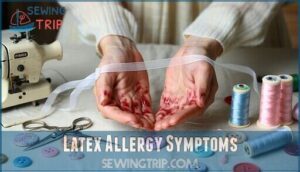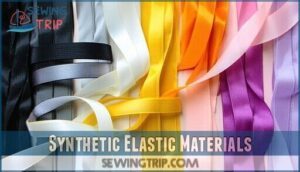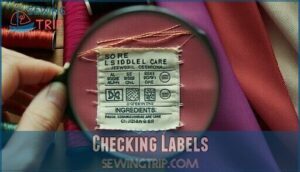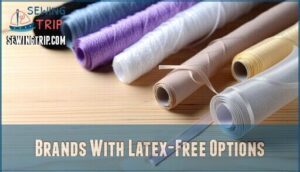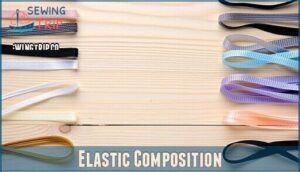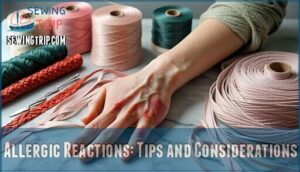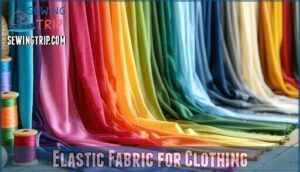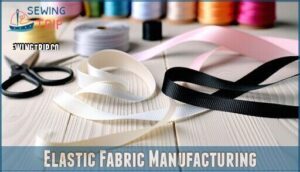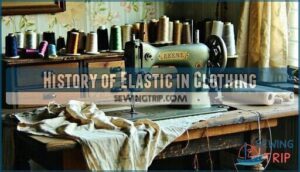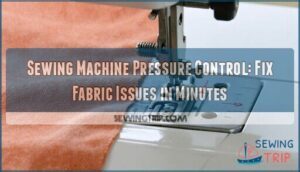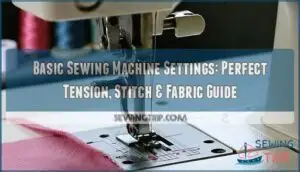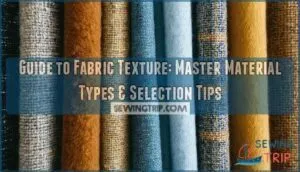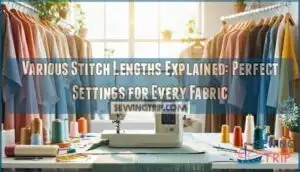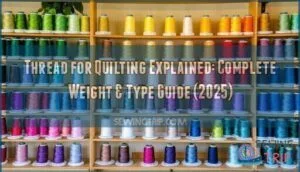This site is supported by our readers. We may earn a commission, at no cost to you, if you purchase through links.
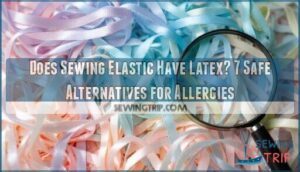 Many sewing elastics do contain latex, but you’re not stuck with itch-inducing options.
Many sewing elastics do contain latex, but you’re not stuck with itch-inducing options.
Traditional rubber elastics rely on natural latex for their stretch, which can trigger allergic reactions ranging from mild skin irritation to serious respiratory issues.
However, manufacturers now offer plenty of latex-free alternatives made from synthetic materials like polyester, spandex, and nylon blends.
These synthetic elastics perform just as well as their latex cousins, giving you the same stretch and recovery without the allergy concerns.
Always check product labels or contact manufacturers directly when in doubt—your skin will thank you for doing the detective work upfront.
Smart sewers know there’s more to elastic selection than meets the eye, and choosing the right elastic can make a significant difference in the comfort and durability of your sewing projects, considering the potential for allergic reactions and the importance of skin sensitivity.
Table Of Contents
- Key Takeaways
- Latex in Sewing Elastics
- Latex Allergy Symptoms
- Latex-Free Alternatives
- Brands With Latex-Free Options
- Elastic Composition
- Allergic Reactions: Tips and Considerations
- Elastic Fabric for Clothing
- Elastic Fabric Manufacturing
- History of Elastic in Clothing
- How to Use Elastic in Sewing
- Frequently Asked Questions (FAQs)
- Conclusion
Key Takeaways
- You’ll find many traditional sewing elastics contain latex, which can trigger allergic reactions ranging from mild skin irritation to serious respiratory issues if you’re sensitive.
- You can choose from numerous latex-free alternatives made with synthetic materials like spandex, polyester, and nylon that perform just as well without allergy concerns.
- You should always check product labels carefully since manufacturers don’t consistently mark latex content, and contact companies directly when labeling isn’t clear about material composition.
- You can find reliable latex-free options from brands like Dritz, Sew Sassy, and Bra-Makers Supply, with types including clear polyurethane, knitted elastic, and silicone-backed varieties for different sewing needs.
Latex in Sewing Elastics
Yes, many sewing elastics contain latex, a natural rubber that provides excellent stretch and durability.
Latex prevalence in elastic sourcing means you’ll often find it in traditional elastic composition, especially in braided and woven varieties.
If you have a latex allergy, this creates real concerns about allergy severity and skin reactions.
Cross-contamination risks also exist when latex and latex-free elastics are manufactured together.
Fortunately, elastic alternatives like spandex, polyester, and neoprene offer similar performance.
Always check labels for latex-free elastic options to avoid elastic degradation issues and guarantee your sewing projects remain comfortable and safe.
Latex Allergy Symptoms
Your body’s alarm system doesn’t mess around when latex enters the picture. Latex allergy symptoms can transform a peaceful sewing session into an uncomfortable experience that leaves you wondering what went wrong.
When latex allergies strike, your peaceful sewing time becomes an uncomfortable battle with your own skin.
Recognizing the warning signs helps you stay ahead of potential problems:
- Skin reactions – redness, itching, hives, or swelling that appears after contact with latex-containing elastic
- Respiratory issues – sneezing, runny nose, or difficulty breathing when handling latex materials
- Allergy severity – symptoms range from mild irritation to serious reactions requiring immediate attention
- Cross-contamination – reactions can occur even when latex-free products are stored with latex-containing items
Diagnosis methods include patch testing by allergists who can confirm latex sensitivity. If you’re experiencing allergic reactions during sewing projects, latex allergy symptoms shouldn’t be ignored. Many sewers discover their latex allergy after repeated exposure to elastic materials.
To avoid skin irritation, consider that linen offers breathability, making it a comfortable alternative for some applications.
The good news? Recognizing these allergy concerns early means you can make informed choices about materials. Understanding your body’s responses helps you navigate toward latex-free alternatives that won’t compromise your creative projects or comfort.
Latex-Free Alternatives
You can absolutely find elastic without latex by choosing synthetic alternatives like spandex, polyester, or neoprene blends.
Always check labels carefully since some elastics contain natural rubber latex while others use completely synthetic materials that won’t trigger allergic reactions, making it a safe choice for those with allergies.
Synthetic Elastic Materials
With synthetic elastic materials, you’ll discover latex-free options that won’t trigger allergic reactions.
These alternatives offer reliable performance through advanced elastomer properties and material blends, ensuring your projects stay comfortable and safe.
| Material Type | Key Benefits |
|---|---|
| Neoprene | Exceptional durability, consistent stretch recovery |
| TPE (Thermoplastic Elastomer) | Superior elasticity, chemical resistance |
| Polyurethane | Lightweight flexibility, moisture resistance |
| Spandex Blends | Reliable stretch, easy alternative sourcing |
These synthetic materials deliver the stretch you need without compromising safety, making them perfect alternatives for anyone managing a latex allergy.
Checking Labels
Before checking ingredients, make sure you’re looking at the right section on the label—certification marks and fine print often hide vital details.
Ingredient verification becomes your safety net when latex allergy strikes. Look for symbols that indicate latex-free elastic composition, scrutinize batch numbers for consistency, and don’t skip the small text where manufacturers list specific materials.
Label scrutiny protects your skin from unwanted reactions. Consider the environmental impact of materials, since sustainable fabric choices can also be gentle on sensitive skin, providing a latex-free alternative and promoting sustainable fabric use.
Brands With Latex-Free Options
You’ll find several trusted brands that specialize in latex-free elastic options for your sewing projects.
These manufacturers clearly label their products and offer extensive ranges of synthetic elastic materials, from clear polyurethane strips to silicone-backed varieties.
Notable Brands
Several trusted manufacturers address allergy concerns through material sourcing and product innovation.
Dritz offers latex-free plush elastic clearly labeled on packaging, while Sew Sassy provides dedicated latex-free selections with thorough brand reputation.
Bra-Makers Supply and Bra Builders claim latex-free status across their elastic variety, though brand comparisons reveal verification remains essential.
These notable brands understand latex allergy symptoms drive consumer choices, making latex-free elastic a priority for safety-conscious sewers.
Some sewers specifically seek Dritz elastic products due to their clear labeling.
Latex-Free Elastic Types
You’ll find various latex-free alternatives when shopping for sewing elastic.
Synthetic elastomers like polyurethane create clear elastic that’s completely latex-free, and TPE elastic offers flexibility without allergy concerns.
While spandex properties provide excellent stretch recovery, silicone elastic grips fabric effectively, and covered elastic conceals synthetic cores.
These latex-free elastic options address common allergy concerns while maintaining performance you need.
Elastic Composition
Understanding what’s actually in your sewing elastic can save you from uncomfortable surprises later.
Know your elastic’s ingredients before the first stitch hits fabric.
Different types of elastic contain varying materials, and knowing their composition helps you choose the right option for your skin sensitivity and project needs.
Clear Elastic
Looking beyond traditional latex options, clear elastic offers a game-changing solution with its 100% polyurethane composition.
This transparent powerhouse eliminates allergy concerns while delivering reliable stretch and recovery for delicate sewing projects.
As a lighter-weight option, it’s best for delicate sewing details.
- Polyurethane composition guarantees complete latex-free performance
- Transparent applications work perfectly with sheer fabrics and lingerie
- Elastic properties maintain durability without sacrificing flexibility
- Sewing techniques benefit from its needle-friendly, non-roll design
Foldover Lingerie Elastic
Foldover lingerie elastic brings together nylon’s durability and spandex’s stretch in a latex-free alternative perfect for sensitive skin.
This elastic composition creates smooth, comfortable edges without latex exposure concerns.
Key benefits for lingerie applications:
- Prevents fabric fraying and rolling
- Offers gentle stretch for comfort
- Creates professional-looking edge finishing
The spandex blend typically contains 110% stretch capacity, making it ideal for sewing techniques that require flexibility.
You’ll find this foldover elastic works beautifully on bra bands, panty legs, and camisole edges where traditional elastic might cause irritation or bulk.
You can purchase foldover lingerie elastic online.
Knitted Elastic
Knitted elastic combines polyester and spandex threads, creating a powerhouse duo that won’t let you down.
Unlike braided varieties, it maintains its width when stretched, making stitching a breeze without needle damage.
| Property | Knitted Elastic | Other Types |
|---|---|---|
| Width Stability | Maintains width | May narrow |
| Needle Compatibility | Excellent | Variable |
| Stretch Recovery | Superior | Good |
| Fabric Weight | Light-medium | All weights |
| Latex Content | Often latex-free | Varies |
This latex-free alternative suits lightweight garments perfectly, offering reliable stretch without triggering allergic reactions from latex exposure.
Many suppliers offer knitted elastic options with superior stretch recovery and excellent needle compatibility, making it an ideal choice for various applications, providing a reliable stretch.
Polyester Elastic
Polyester elastic’s composition packs a punch with 66% polyester and 34% elastomer, creating a reliable workhorse for your sewing projects.
This latex-free alternative delivers consistent performance without triggering allergic reactions, making it perfect for sensitive sewers who need dependable stretch.
Here’s why polyester elastic earns top marks:
- Polyester Properties deliver exceptional tensile strength – the high polyester content resists breaking under stress, ensuring your garments won’t fail when you need them most.
- Elastic Durability stands the test of time – unlike natural rubber that degrades, this synthetic blend maintains its integrity through countless wash cycles and wear.
- Stretch Recovery bounces back reliably – the elastomer component provides consistent snap-back action, preventing sagging waistbands and loose-fitting garments.
Material verification through label scrutiny confirms you’re getting latex-free alternatives that won’t cause skin irritation.
You can find various sewing elastics online.
Blends comparison shows polyester elastic outperforms many natural options for sewing applications, giving you peace of mind with every stitch.
Silicone Backed Elastic
Silicone-backed elastic brings together the best of three worlds: rubber cores provide stretch, while silicone grip prevents slipping and nylon adds strength.
This latex-free elastic works perfectly for waistbands that need to stay put.
Specialty elastics offer unique properties for niche uses.
| Component | Function | Benefit |
|---|---|---|
| Silicone backing | Anti-slip grip | Prevents rolling/shifting |
| Spandex/rubber core | Stretch recovery | Maintains elasticity |
| Nylon covering | Durability | Resists wear/tear |
| Composite design | Fabric compatibility | Works with various materials |
Sewing techniques for silicone elastic require careful handling since the grip can catch fabric during application.
For allergy management, this latex-free elastic eliminates allergic reactions while providing superior hold for applications requiring secure positioning.
Swimwear Elastic
When you’re crafting swimwear, specialized elastic becomes your trusted ally against pool chemicals and ocean adventures.
Swimwear elastic features latex-free compositions using chlorine-resistant materials that won’t break down from repeated exposure, making it perfect for allergy management without compromising performance.
Here’s what makes swimwear elastic stand out:
- Chlorine Resistance – Maintains elasticity after countless pool sessions
- Saltwater Durability – Resists corrosion from ocean minerals and salt
- UV Degradation Protection – Won’t deteriorate under intense sun exposure
This specialized elastic guarantees stretch retention through proper application techniques, keeping your swimwear fitting perfectly season after season while addressing allergenic concerns.
Finishing Plush Elastic
Why settle for rough edges when you can enjoy buttery-soft comfort? Finishing plush elastic features polyester pile backing over synthetic cores, eliminating latex and allergenic concerns.
This sewing elastic provides gentle skin contact while maintaining stretch recovery. Perfect for Plush Elastic Applications like waistbands and cuffs, it requires careful Stitching Plush Elastic techniques to prevent pile damage.
When Securing Plush Elastic, use stretch stitches for durability. Proper Plush Elastic Care involves gentle washing to preserve the soft texture of Plush Elastic Edges.
Strapping Plush Elastic
Beyond basic plush elastic lies strapping plush elastic, your heavyweight champion for demanding projects.
This latex-free alternative combines 88% nylon with 12% spandex, delivering exceptional strength without allergy concerns.
Here’s why crafters choose strapping plush elastic:
- Superior durability – withstands repeated stretching and washing cycles
- Versatile widths – accommodates various project requirements and strapping attachment methods
- Consistent tension control – maintains even pressure across different stitch types
This synthetic elastic proves that latex-free alternatives don’t compromise performance, offering reliable stretch recovery for heavy-duty applications.
Allergic Reactions: Tips and Considerations
If you’re sensitive to latex, you’ll want to carefully check your elastic materials before starting any sewing project.
Many people don’t realize that some sewing elastics contain natural latex, which can trigger uncomfortable skin reactions like itching, redness, or even more serious allergic responses, including skin reactions.
Latex-Free Materials
When choosing latex-free alternatives, synthetic elastomers like polyester and nylon eliminate allergy risks entirely.
Material verification through checking labels guarantees proper allergy management for your creative sewing projects.
These latex-free elastic types offer reliable stretch without compromising safety or performance.
| Material | Stretch % | Best Use |
|---|---|---|
| Polyester | 85-95% | Waistbands |
| Nylon | 90-110% | Activewear |
| Spandex | 100-150% | Form-fitting |
| Neoprene | 80-120% | Swimwear |
| TPE | 75-100% | Medical garments |
Product comparisons reveal these latex-free alternatives match traditional latex’s performance while providing peace of mind for sensitive sewers, ensuring a reliable stretch without compromising safety.
Checking Dritz Elastics
When examining Dritz’s extensive elastic collection, you’ll find both latex-containing and latex-free options, making careful label reading essential for allergy management.
Don’t assume all Dritz elastics are latex-free—some contain natural rubber latex that can trigger reactions.
- Check product packaging for "latex-free" certification or natural rubber latex warnings
- Contact Dritz directly if labeling seems unclear about specific material sourcing
- Test small samples on skin before incorporating into garments for sensitive users
Label accuracy varies across Dritz elastic types, so verify material composition through product variations and allergy warnings to confirm you’re selecting appropriate latex-free alternatives.
Elastic Fabric for Clothing
Elastic fabrics transform your wardrobe by delivering unmatched clothing comfort and freedom of movement.
These stretch-friendly materials contain various elastic types, from spandex to polyurethane, each offering distinct elastic durability and stretch recovery properties.
You’ll find elastic materials in everything from yoga pants to dress shirts, where they provide flexibility without sacrificing style.
When selecting garments, you’ll encounter different elastic applications depending on your needs.
Activewear typically uses high-performance latexfree elastic for maximum stretch recovery, while casual clothing might feature softer elastic materials for everyday comfort.
Understanding these elastic types helps you choose clothes that move with you throughout your day.
For those with sensitivities, latexfree alternatives have revolutionized clothing options.
Modern sewing techniques now incorporate synthetic elastic materials that deliver the same performance as traditional latex-based options.
Whether you’re shopping for underwear or athletic wear, you can find comfortable, stretchy fabrics that won’t trigger allergic reactions while maintaining the elastic durability you need.
Elastic Fabric Manufacturing
Understanding how manufacturers create sewing elastic helps you make informed choices for your projects.
The manufacturing process determines whether your elastic contains latex or offers safer alternatives for sensitive skin.
Here’s how elastic fabric manufacturing works:
- Fiber Processing: Manufacturers blend synthetic materials like spandex, polyester, and nylon to create latex-free elastic with consistent stretch properties.
- Core Construction: Engineers design elastic cores using thermoplastic elastomers or rubber compounds, determining the final product’s flexibility and durability.
- Weaving Methods: Advanced knitting and braiding techniques integrate elastic fibers with covering materials, creating different elastic types for specific applications.
- Material Properties: Quality control verifies proper elastic pliancy, testing stretch recovery and tensile strength to meet industry standards.
**Spandex offers versatility in athletic wear.
- Final Processing: Manufacturers apply finishing treatments and perform latex testing to guarantee safe, reliable elastic materials for your sewing projects.
History of Elastic in Clothing
You might think elastic in clothing is a recent invention, but elastic history tells a different story.
Early Rubber Use dates back centuries before Columbus arrived in the Americas.
American Indians already knew rubber’s stretchy properties, calling it the "weeping tree."
The Mayans created primitive elastic bands from vine juices – early Mayan Elastic that proves ancient innovation.
These cultures understood rubber’s potential long before modern manufacturing.
Fast-forward to the 1820s, when Thomas Hancock’s Invention revolutionized elastic production.
Hancock developed modern elastic for gloves, shoes, and suspenders.
His work laid the groundwork for today’s synthetic materials.
William Spencer’s Bands followed in 1923, bringing mass-produced rubber bands to the world.
Around the same time, Charles Macintosh’s Discovery of coal tar naphtha helped dissolve rubber, creating waterproof clothing.
This elastic evolution shows how latex and rubber transformed from ancient curiosities into modern necessities.
Today’s synthetic alternatives continue this long tradition of innovation.
How to Use Elastic in Sewing
Now that you understand the rich history behind elastic materials, let’s explore how you can master elastic sewing techniques for your projects.
Whether you’re working with latex-free options or traditional elastic types, proper application makes all the difference in your finished garment.
Start by testing your elastic’s rebound before cutting – stretch it fully, then release to confirm it snaps back properly. This elastic rebound testing prevents disappointing surprises later.
Here are four key techniques for successful elastic application:
- Casing vs Direct Method: Thread elastic through fabric casings for hidden waistbands, or stitch directly onto fabric for exposed decorative effects
- Elastic Tension Control: Pin elastic at quarter marks while stretching evenly to prevent bunching or puckering
- Even Elastic Distribution: Use safety pins to mark equal sections before sewing, ensuring consistent gather distribution
- Elastic Stitching Techniques: Choose zigzag, stretch stitch, or serger methods based on your fabric weight and desired durability
These methods work equally well with synthetic alternatives, giving you flexibility in your sewing approach.
Frequently Asked Questions (FAQs)
What type of elastic should I use for sewing?
Before you worry about finding the "perfect" elastic, know that most modern sewing elastics work great for general projects.
Choose knitted elastic for lightweight fabrics, woven for heavy-duty support, or braided for casings – it depends on your fabric weight and stretch needs.
What are the different types of sewing elastics?
You’ll find several elastic types for different sewing needs: knitted elastic stays soft and stretchy, woven elastic provides stronger support.
Braided elastic offers maximum stretch, and specialty options like silicone-backed or foldover elastic serve specific applications.
Can you sew with elastic thread?
You’ll discover elastic thread’s surprisingly versatile – it automatically gathers fabric as you sew, creating beautiful shirring effects.
Use it in your bobbin while keeping regular thread on top for professional-looking smocked waistbands and fitted bodices.
Is elastic good for clothes?
Elastic revolutionizes your clothing by providing stretch, comfort, and flexibility. You’ll find it essential for waistbands, cuffs, and fitted garments, offering adjustable fits without bulky closures while maintaining shape.
What is latex-free elastic?
Like ye olde corset-makers switching from whalebone, modern latex-free elastic uses synthetic materials—spandex, polyurethane, neoprene, or polyester—instead of natural rubber latex.
This change prevents allergic reactions while maintaining stretch and durability.
Why is elastic important in sewing?
You’ll discover elastic provides essential stretch, comfort, and flexibility in garments.
It creates adjustable waistbands, gathers fabric, guarantees proper fit, and allows clothes to move naturally with your body without restricting movement, providing comfort.
Do elastic bands have latex in them?
Think of elastic bands like mystery ingredients in your favorite recipe—some contain natural latex from rubber trees, while others use synthetic alternatives.
Yes, many elastic bands do contain latex, which can trigger allergic reactions in sensitive individuals.
However, you’ll find plenty of latex-free options made from materials like spandex, polyester, and neoprene that provide the same stretch and durability without the allergy concerns, making them a great alternative for those with sensitivity, and they are often made with synthetic alternatives.
What is latex free elastic made of?
You’ll find latex-free elastic made from synthetic materials like spandex, polyester, nylon, polyurethane, and neoprene. These alternatives provide flexibility and stretch without triggering allergic reactions in sensitive individuals.
Can latex elastic cause respiratory problems?
Up to 17% of healthcare workers develop latex allergies.
Yes, latex elastic can trigger respiratory problems if you’re allergic—inhaling latex particles causes wheezing, coughing, and breathing difficulties, especially during cutting or handling.
How long do latex allergic reactions last?
Latex allergic reactions typically last 24-48 hours for mild skin reactions, but you’ll need to avoid the allergen completely.
Severe reactions require immediate medical attention and recovery varies by individual sensitivity.
Conclusion
Picture yourself confidently selecting elastic without worrying about hidden allergens lurking in your sewing basket.
Understanding whether sewing elastic contains latex empowers you to make informed choices for your projects.
While traditional rubber elastics often contain latex, synthetic alternatives like polyester, spandex, and nylon blends offer excellent performance without allergic reactions.
By reading labels carefully and choosing reputable latex-free brands, you’ll guarantee comfort and safety in every stitch, making your sewing experience both enjoyable and worry-free for sensitive skin.

